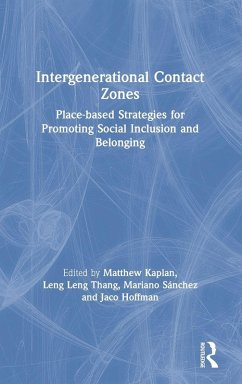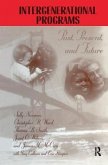Intergenerational Contact Zones
Place-based Strategies for Promoting Social Inclusion and Belonging
Herausgeber: Kaplan, Matthew; Sánchez, Mariano; Thang, Leng Leng
Intergenerational Contact Zones
Place-based Strategies for Promoting Social Inclusion and Belonging
Herausgeber: Kaplan, Matthew; Sánchez, Mariano; Thang, Leng Leng
- Gebundenes Buch
- Merkliste
- Auf die Merkliste
- Bewerten Bewerten
- Teilen
- Produkt teilen
- Produkterinnerung
- Produkterinnerung
Intergenerational Contact Zones is the first book to explore the foundations and applications of intergenerational contact zones (ICZs) from an international perspective. This important volume focuses on practical descriptions and developments to nurture practitioners' and researchers' capacity to translate ICZs into their work.
Andere Kunden interessierten sich auch für
![Intergenerational Programs Intergenerational Programs]() Sally NewmanIntergenerational Programs158,99 €
Sally NewmanIntergenerational Programs158,99 €![Intergenerational Complexes in Analytical Psychology Intergenerational Complexes in Analytical Psychology]() Samuel L KimblesIntergenerational Complexes in Analytical Psychology168,99 €
Samuel L KimblesIntergenerational Complexes in Analytical Psychology168,99 €![Environmental Psychology in Europe Environmental Psychology in Europe]() Enric PolEnvironmental Psychology in Europe128,99 €
Enric PolEnvironmental Psychology in Europe128,99 €![Object Relations in Gestalt Therapy Object Relations in Gestalt Therapy]() Gilles DelisleObject Relations in Gestalt Therapy158,99 €
Gilles DelisleObject Relations in Gestalt Therapy158,99 €![Body Process Body Process]() James I. KepnerBody Process167,99 €
James I. KepnerBody Process167,99 €![Using Intergroup Contact to Fight Prejudice and Negative Attitudes Using Intergroup Contact to Fight Prejudice and Negative Attitudes]() Loris VezzaliUsing Intergroup Contact to Fight Prejudice and Negative Attitudes168,99 €
Loris VezzaliUsing Intergroup Contact to Fight Prejudice and Negative Attitudes168,99 €![The Cambridge Handbook of Ethics and Education The Cambridge Handbook of Ethics and Education]() The Cambridge Handbook of Ethics and Education219,99 €
The Cambridge Handbook of Ethics and Education219,99 €-
-
-
Intergenerational Contact Zones is the first book to explore the foundations and applications of intergenerational contact zones (ICZs) from an international perspective. This important volume focuses on practical descriptions and developments to nurture practitioners' and researchers' capacity to translate ICZs into their work.
Produktdetails
- Produktdetails
- Verlag: Routledge
- Seitenzahl: 352
- Erscheinungstermin: 5. März 2020
- Englisch
- Abmessung: 235mm x 157mm x 23mm
- Gewicht: 661g
- ISBN-13: 9780367189020
- ISBN-10: 036718902X
- Artikelnr.: 75647233
- Herstellerkennzeichnung
- Libri GmbH
- Europaallee 1
- 36244 Bad Hersfeld
- gpsr@libri.de
- Verlag: Routledge
- Seitenzahl: 352
- Erscheinungstermin: 5. März 2020
- Englisch
- Abmessung: 235mm x 157mm x 23mm
- Gewicht: 661g
- ISBN-13: 9780367189020
- ISBN-10: 036718902X
- Artikelnr.: 75647233
- Herstellerkennzeichnung
- Libri GmbH
- Europaallee 1
- 36244 Bad Hersfeld
- gpsr@libri.de
Dr. Matthew Kaplan is Professor of Intergenerational Programs and Aging in the Department of Agricultural Economics, Sociology, and Education at Pennsylvania State University. He is an affiliate member of the Penn State Center for Healthy Aging and core faculty member of the Comparative and International Education (CIED) Dual-Title Graduate Degree Program. Dr. Leng Leng Thang is Associate Professor and Head of Department of Japanese Studies, Faculty of Arts and Social Sciences, National University of Singapore. She is also is co-director of the Next Age Institute. Dr. Mariano Sánchez is Associate Professor of Sociology and inaugural head of the Macrosad Chair in Intergenerational Studies at the University of Granada in Spain. Professor Sánchez is as well International Affiliate at the Center for Healthy Aging (Pennsylvania State University), and director of the Intergenerational Spaces Lab. Dr. Jaco Hoffman, DPhil (Oxon), is socio-gerontologist and leader of the Optentia Research Focus programme: Ageing and Generational Dynamics in Africa (AGenDA) at North-West University, South Africa as well as James Martin Senior Research Fellow in the Oxford Institute of Population Ageing at the University of Oxford, UK.
Introduction
Part I. Generation/Regeneration of Community Life
Chapter 1. Culture as Animator of Intergenerational Gathering Places
Robert H. McNulty
Chapter 2. Our Community, Our Traditional Food: Around the Fire as an
Intergenerational Contact Zone
Shingaira Chigeza, Nicole Claasen and Vera Roos
Chapter 3. Finding Fertile Ground in Libraries for Intergenerational Dance
Yvonne Ng
Chapter 4. Transforming a barn into an 'intergenerational planning zone"
Matthew Kaplan, Suzanna Windon, and Evan Zavada
Chapter 5. City Cycling Spaces for Welcoming and Engaging All Ages
Tim Jones and Ben Spencer
Chapter 6. Playful Perspectives and Everyday Spaces: Imagining a Bus Stop
as an Intergenerational Contact Zone
Jason Danely
Part II. Parks and Recreation
Chapter 7. Connecting generations in Chinese urban parks
Patricia O'Neill
Chapter 8. Urban Public Parks: Magnets for Social Inclusion and Engagement
across Generations
Cláudia Azevedo
Chapter 9. Intergenerational Gardening on Urban Rooftops: The Example of
the "Play and Grow" Program in Hong Kong
Tanja Sobko and Louise Chawla
Chapter 10. Forests as Intergenerational Contact Zones: Teaching About and
Experiencing Forests Through Historical Interpretation
Sanford S. Smith and Matthew S. Kaplan
Chapter 11. Sowing Connections in a Community Garden: An Intergenerational
Partnership between Young Adult Cancer Survivors and Master Gardeners
Renate M. Winkels, Rick Artrip, Maegan Tupinio and Daniel R. George
Part III. Education Settings
Chapter 12. Schools as Intergenerational Contact Zones: The Cleveland Case
Catherine Whitehouse, Peter Whitehouse, & Mariano Sánchez
Chapter 13. College Classrooms as Intergenerational Contact Zones
Joann M. Montepare and Mark Sciegaj
Chapter 14. Adding Excitement and Relevance to Second Language Learning:
Imagining a School-based English Language Center as an Intergenerational
Contact Zone
Alan Lai
Part IV. Residential Settings and Family Life
Chapter 15. Intergenerational Living in Cohousing Communities
Lisia Zheng
Chapter 16. Cocktails in Care Homes: An intergenerational strategy for
bridging the care home - community divide
Phoebe Grudzinskas and Susan Langford
Chapter 17. Senior Housing as a Community Hub for Intergenerational
Interaction
Nancy Henkin and Taryn Patterson
Chapter 18. The Japanese teapot: Objects at home that possess
Intergenerational Contact Zone generating properties
Yoshika Yamamoto and Leng Leng Thang
Chapter 19. The Virtual Environment as Intergenerational Contact Zone: Play
through Digital Gaming
Eyu Zang
Part V. Social Development: National/International Contexts
Chapter 20. Multigenerational Cyclical Support System: Programs in Japan
for "Designing a Sustainable Society through Intergenerational
Co-creation."
Masataka Kuraoka
Chapter 21. Exploring Design Principles and Strategies for
Intergenerational Places in Australia: Revealing Opportunities and
Potential in Beach and Public Pool Settings.
Kah Mun Tham, Diane Jones and Ann Quinlan; Architect
Chapter 22. Intergenerational Contact Zones in Contested Places and Spaces:
The Olive Tree as Entity and Symbol
Suzanne Hammad
Part VI. Methods
Chapter 23. A Toolkit for Intergenerational Contact Zones Application
Mariano Sánchez and Philip B. Stafford
Chapter 24. Intergenerational programs and intergenerational contact zones:
Aligning notions of 'good quality'
Mariano Sánchez, Pilar Díaz, Andrés Rodríguez and Rosa Bonachela
Chapter 25. Everyone Can Make a Map: Multigenerational and
Intergenerational Explorations of Community
Philip B. Stafford
Conclusion
Part I. Generation/Regeneration of Community Life
Chapter 1. Culture as Animator of Intergenerational Gathering Places
Robert H. McNulty
Chapter 2. Our Community, Our Traditional Food: Around the Fire as an
Intergenerational Contact Zone
Shingaira Chigeza, Nicole Claasen and Vera Roos
Chapter 3. Finding Fertile Ground in Libraries for Intergenerational Dance
Yvonne Ng
Chapter 4. Transforming a barn into an 'intergenerational planning zone"
Matthew Kaplan, Suzanna Windon, and Evan Zavada
Chapter 5. City Cycling Spaces for Welcoming and Engaging All Ages
Tim Jones and Ben Spencer
Chapter 6. Playful Perspectives and Everyday Spaces: Imagining a Bus Stop
as an Intergenerational Contact Zone
Jason Danely
Part II. Parks and Recreation
Chapter 7. Connecting generations in Chinese urban parks
Patricia O'Neill
Chapter 8. Urban Public Parks: Magnets for Social Inclusion and Engagement
across Generations
Cláudia Azevedo
Chapter 9. Intergenerational Gardening on Urban Rooftops: The Example of
the "Play and Grow" Program in Hong Kong
Tanja Sobko and Louise Chawla
Chapter 10. Forests as Intergenerational Contact Zones: Teaching About and
Experiencing Forests Through Historical Interpretation
Sanford S. Smith and Matthew S. Kaplan
Chapter 11. Sowing Connections in a Community Garden: An Intergenerational
Partnership between Young Adult Cancer Survivors and Master Gardeners
Renate M. Winkels, Rick Artrip, Maegan Tupinio and Daniel R. George
Part III. Education Settings
Chapter 12. Schools as Intergenerational Contact Zones: The Cleveland Case
Catherine Whitehouse, Peter Whitehouse, & Mariano Sánchez
Chapter 13. College Classrooms as Intergenerational Contact Zones
Joann M. Montepare and Mark Sciegaj
Chapter 14. Adding Excitement and Relevance to Second Language Learning:
Imagining a School-based English Language Center as an Intergenerational
Contact Zone
Alan Lai
Part IV. Residential Settings and Family Life
Chapter 15. Intergenerational Living in Cohousing Communities
Lisia Zheng
Chapter 16. Cocktails in Care Homes: An intergenerational strategy for
bridging the care home - community divide
Phoebe Grudzinskas and Susan Langford
Chapter 17. Senior Housing as a Community Hub for Intergenerational
Interaction
Nancy Henkin and Taryn Patterson
Chapter 18. The Japanese teapot: Objects at home that possess
Intergenerational Contact Zone generating properties
Yoshika Yamamoto and Leng Leng Thang
Chapter 19. The Virtual Environment as Intergenerational Contact Zone: Play
through Digital Gaming
Eyu Zang
Part V. Social Development: National/International Contexts
Chapter 20. Multigenerational Cyclical Support System: Programs in Japan
for "Designing a Sustainable Society through Intergenerational
Co-creation."
Masataka Kuraoka
Chapter 21. Exploring Design Principles and Strategies for
Intergenerational Places in Australia: Revealing Opportunities and
Potential in Beach and Public Pool Settings.
Kah Mun Tham, Diane Jones and Ann Quinlan; Architect
Chapter 22. Intergenerational Contact Zones in Contested Places and Spaces:
The Olive Tree as Entity and Symbol
Suzanne Hammad
Part VI. Methods
Chapter 23. A Toolkit for Intergenerational Contact Zones Application
Mariano Sánchez and Philip B. Stafford
Chapter 24. Intergenerational programs and intergenerational contact zones:
Aligning notions of 'good quality'
Mariano Sánchez, Pilar Díaz, Andrés Rodríguez and Rosa Bonachela
Chapter 25. Everyone Can Make a Map: Multigenerational and
Intergenerational Explorations of Community
Philip B. Stafford
Conclusion
Introduction
Part I. Generation/Regeneration of Community Life
Chapter 1. Culture as Animator of Intergenerational Gathering Places
Robert H. McNulty
Chapter 2. Our Community, Our Traditional Food: Around the Fire as an
Intergenerational Contact Zone
Shingaira Chigeza, Nicole Claasen and Vera Roos
Chapter 3. Finding Fertile Ground in Libraries for Intergenerational Dance
Yvonne Ng
Chapter 4. Transforming a barn into an 'intergenerational planning zone"
Matthew Kaplan, Suzanna Windon, and Evan Zavada
Chapter 5. City Cycling Spaces for Welcoming and Engaging All Ages
Tim Jones and Ben Spencer
Chapter 6. Playful Perspectives and Everyday Spaces: Imagining a Bus Stop
as an Intergenerational Contact Zone
Jason Danely
Part II. Parks and Recreation
Chapter 7. Connecting generations in Chinese urban parks
Patricia O'Neill
Chapter 8. Urban Public Parks: Magnets for Social Inclusion and Engagement
across Generations
Cláudia Azevedo
Chapter 9. Intergenerational Gardening on Urban Rooftops: The Example of
the "Play and Grow" Program in Hong Kong
Tanja Sobko and Louise Chawla
Chapter 10. Forests as Intergenerational Contact Zones: Teaching About and
Experiencing Forests Through Historical Interpretation
Sanford S. Smith and Matthew S. Kaplan
Chapter 11. Sowing Connections in a Community Garden: An Intergenerational
Partnership between Young Adult Cancer Survivors and Master Gardeners
Renate M. Winkels, Rick Artrip, Maegan Tupinio and Daniel R. George
Part III. Education Settings
Chapter 12. Schools as Intergenerational Contact Zones: The Cleveland Case
Catherine Whitehouse, Peter Whitehouse, & Mariano Sánchez
Chapter 13. College Classrooms as Intergenerational Contact Zones
Joann M. Montepare and Mark Sciegaj
Chapter 14. Adding Excitement and Relevance to Second Language Learning:
Imagining a School-based English Language Center as an Intergenerational
Contact Zone
Alan Lai
Part IV. Residential Settings and Family Life
Chapter 15. Intergenerational Living in Cohousing Communities
Lisia Zheng
Chapter 16. Cocktails in Care Homes: An intergenerational strategy for
bridging the care home - community divide
Phoebe Grudzinskas and Susan Langford
Chapter 17. Senior Housing as a Community Hub for Intergenerational
Interaction
Nancy Henkin and Taryn Patterson
Chapter 18. The Japanese teapot: Objects at home that possess
Intergenerational Contact Zone generating properties
Yoshika Yamamoto and Leng Leng Thang
Chapter 19. The Virtual Environment as Intergenerational Contact Zone: Play
through Digital Gaming
Eyu Zang
Part V. Social Development: National/International Contexts
Chapter 20. Multigenerational Cyclical Support System: Programs in Japan
for "Designing a Sustainable Society through Intergenerational
Co-creation."
Masataka Kuraoka
Chapter 21. Exploring Design Principles and Strategies for
Intergenerational Places in Australia: Revealing Opportunities and
Potential in Beach and Public Pool Settings.
Kah Mun Tham, Diane Jones and Ann Quinlan; Architect
Chapter 22. Intergenerational Contact Zones in Contested Places and Spaces:
The Olive Tree as Entity and Symbol
Suzanne Hammad
Part VI. Methods
Chapter 23. A Toolkit for Intergenerational Contact Zones Application
Mariano Sánchez and Philip B. Stafford
Chapter 24. Intergenerational programs and intergenerational contact zones:
Aligning notions of 'good quality'
Mariano Sánchez, Pilar Díaz, Andrés Rodríguez and Rosa Bonachela
Chapter 25. Everyone Can Make a Map: Multigenerational and
Intergenerational Explorations of Community
Philip B. Stafford
Conclusion
Part I. Generation/Regeneration of Community Life
Chapter 1. Culture as Animator of Intergenerational Gathering Places
Robert H. McNulty
Chapter 2. Our Community, Our Traditional Food: Around the Fire as an
Intergenerational Contact Zone
Shingaira Chigeza, Nicole Claasen and Vera Roos
Chapter 3. Finding Fertile Ground in Libraries for Intergenerational Dance
Yvonne Ng
Chapter 4. Transforming a barn into an 'intergenerational planning zone"
Matthew Kaplan, Suzanna Windon, and Evan Zavada
Chapter 5. City Cycling Spaces for Welcoming and Engaging All Ages
Tim Jones and Ben Spencer
Chapter 6. Playful Perspectives and Everyday Spaces: Imagining a Bus Stop
as an Intergenerational Contact Zone
Jason Danely
Part II. Parks and Recreation
Chapter 7. Connecting generations in Chinese urban parks
Patricia O'Neill
Chapter 8. Urban Public Parks: Magnets for Social Inclusion and Engagement
across Generations
Cláudia Azevedo
Chapter 9. Intergenerational Gardening on Urban Rooftops: The Example of
the "Play and Grow" Program in Hong Kong
Tanja Sobko and Louise Chawla
Chapter 10. Forests as Intergenerational Contact Zones: Teaching About and
Experiencing Forests Through Historical Interpretation
Sanford S. Smith and Matthew S. Kaplan
Chapter 11. Sowing Connections in a Community Garden: An Intergenerational
Partnership between Young Adult Cancer Survivors and Master Gardeners
Renate M. Winkels, Rick Artrip, Maegan Tupinio and Daniel R. George
Part III. Education Settings
Chapter 12. Schools as Intergenerational Contact Zones: The Cleveland Case
Catherine Whitehouse, Peter Whitehouse, & Mariano Sánchez
Chapter 13. College Classrooms as Intergenerational Contact Zones
Joann M. Montepare and Mark Sciegaj
Chapter 14. Adding Excitement and Relevance to Second Language Learning:
Imagining a School-based English Language Center as an Intergenerational
Contact Zone
Alan Lai
Part IV. Residential Settings and Family Life
Chapter 15. Intergenerational Living in Cohousing Communities
Lisia Zheng
Chapter 16. Cocktails in Care Homes: An intergenerational strategy for
bridging the care home - community divide
Phoebe Grudzinskas and Susan Langford
Chapter 17. Senior Housing as a Community Hub for Intergenerational
Interaction
Nancy Henkin and Taryn Patterson
Chapter 18. The Japanese teapot: Objects at home that possess
Intergenerational Contact Zone generating properties
Yoshika Yamamoto and Leng Leng Thang
Chapter 19. The Virtual Environment as Intergenerational Contact Zone: Play
through Digital Gaming
Eyu Zang
Part V. Social Development: National/International Contexts
Chapter 20. Multigenerational Cyclical Support System: Programs in Japan
for "Designing a Sustainable Society through Intergenerational
Co-creation."
Masataka Kuraoka
Chapter 21. Exploring Design Principles and Strategies for
Intergenerational Places in Australia: Revealing Opportunities and
Potential in Beach and Public Pool Settings.
Kah Mun Tham, Diane Jones and Ann Quinlan; Architect
Chapter 22. Intergenerational Contact Zones in Contested Places and Spaces:
The Olive Tree as Entity and Symbol
Suzanne Hammad
Part VI. Methods
Chapter 23. A Toolkit for Intergenerational Contact Zones Application
Mariano Sánchez and Philip B. Stafford
Chapter 24. Intergenerational programs and intergenerational contact zones:
Aligning notions of 'good quality'
Mariano Sánchez, Pilar Díaz, Andrés Rodríguez and Rosa Bonachela
Chapter 25. Everyone Can Make a Map: Multigenerational and
Intergenerational Explorations of Community
Philip B. Stafford
Conclusion








